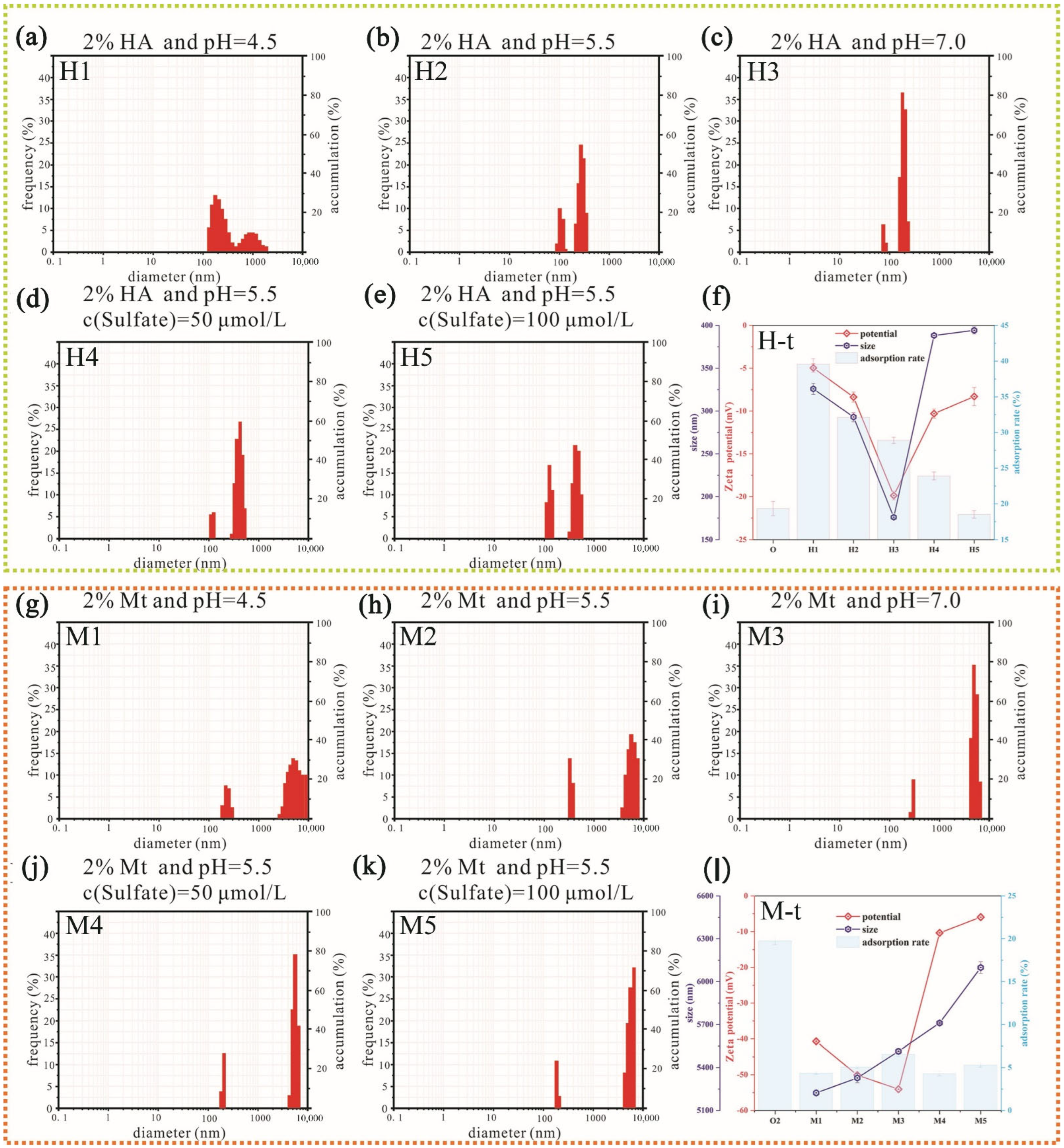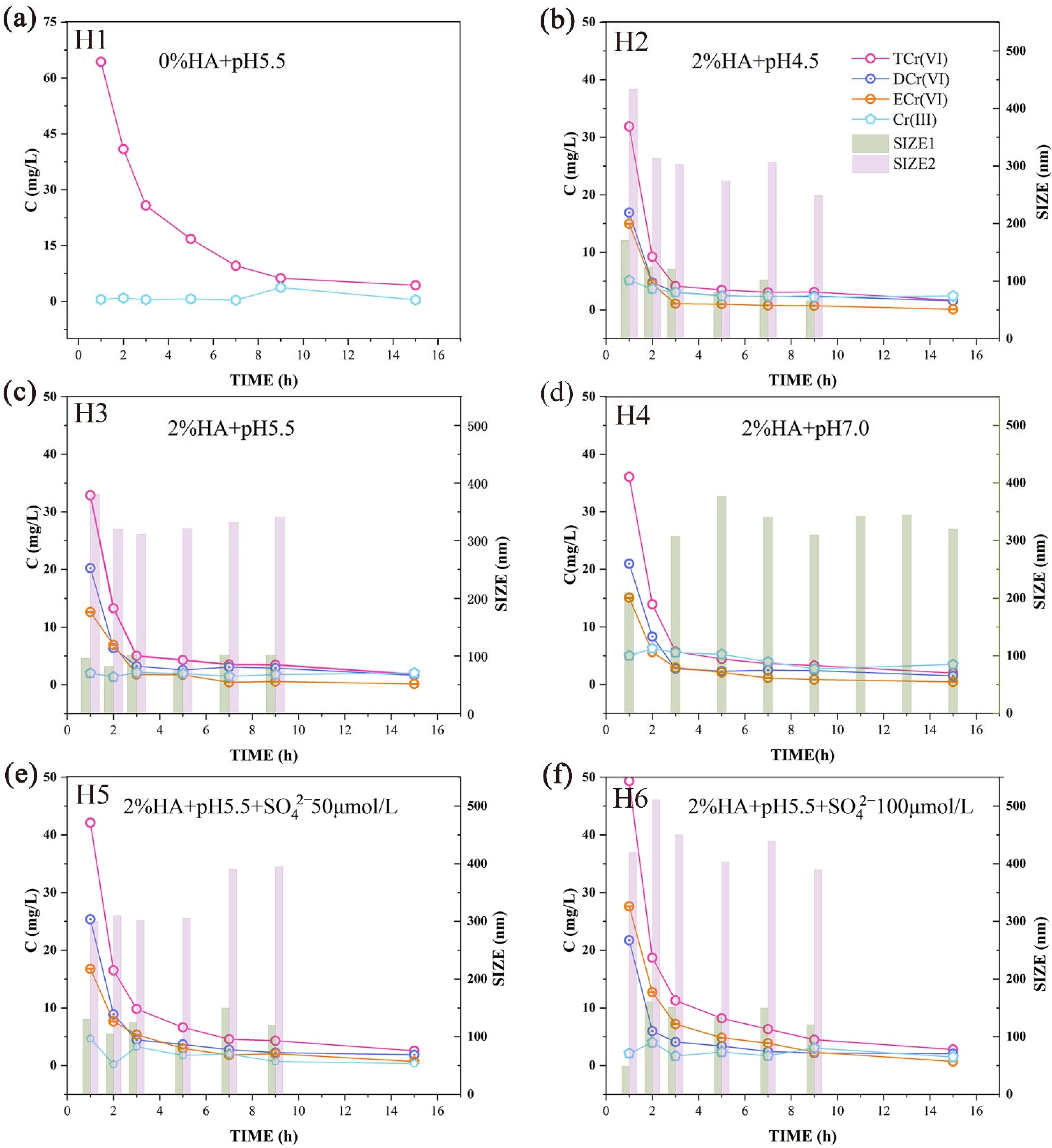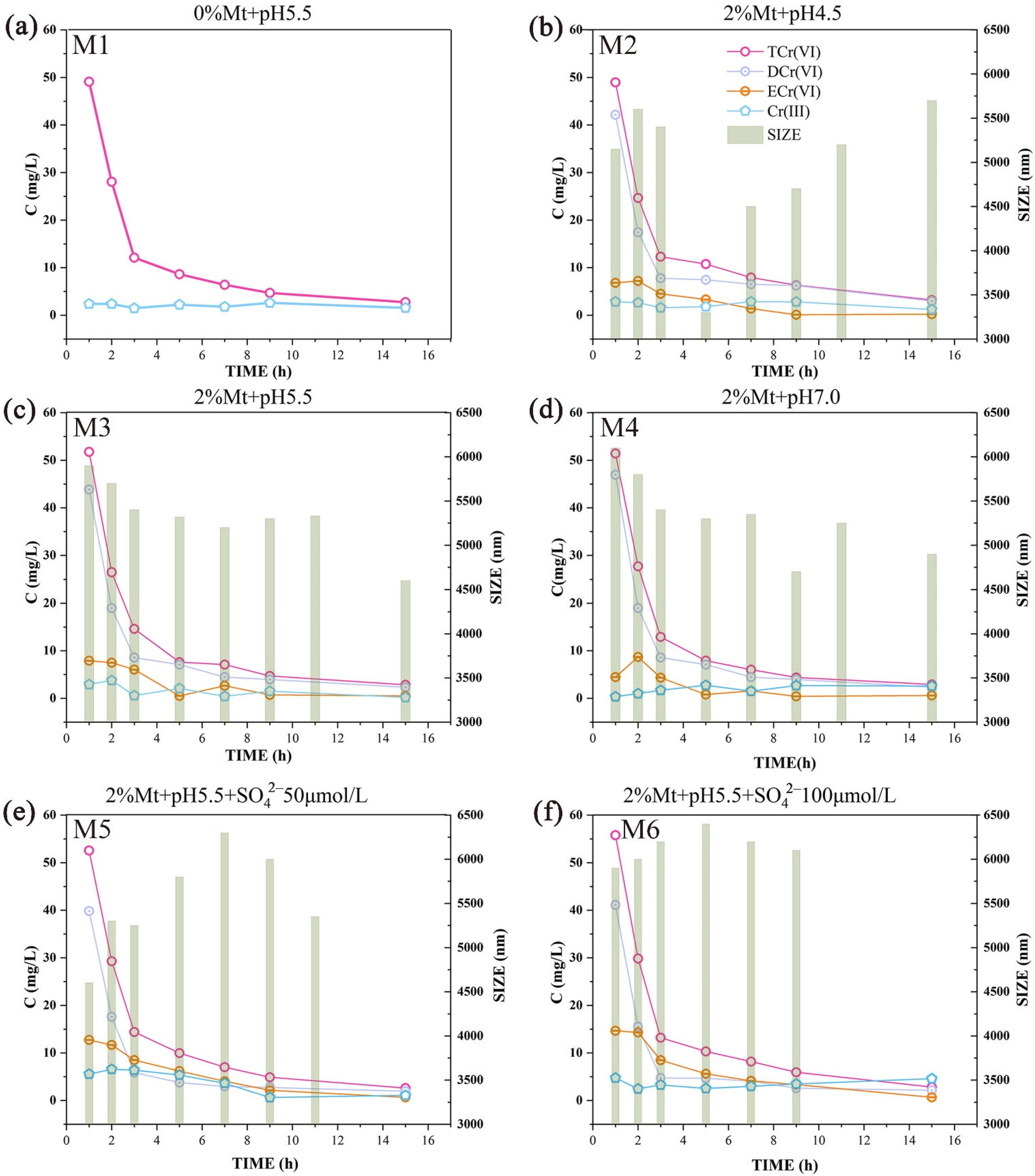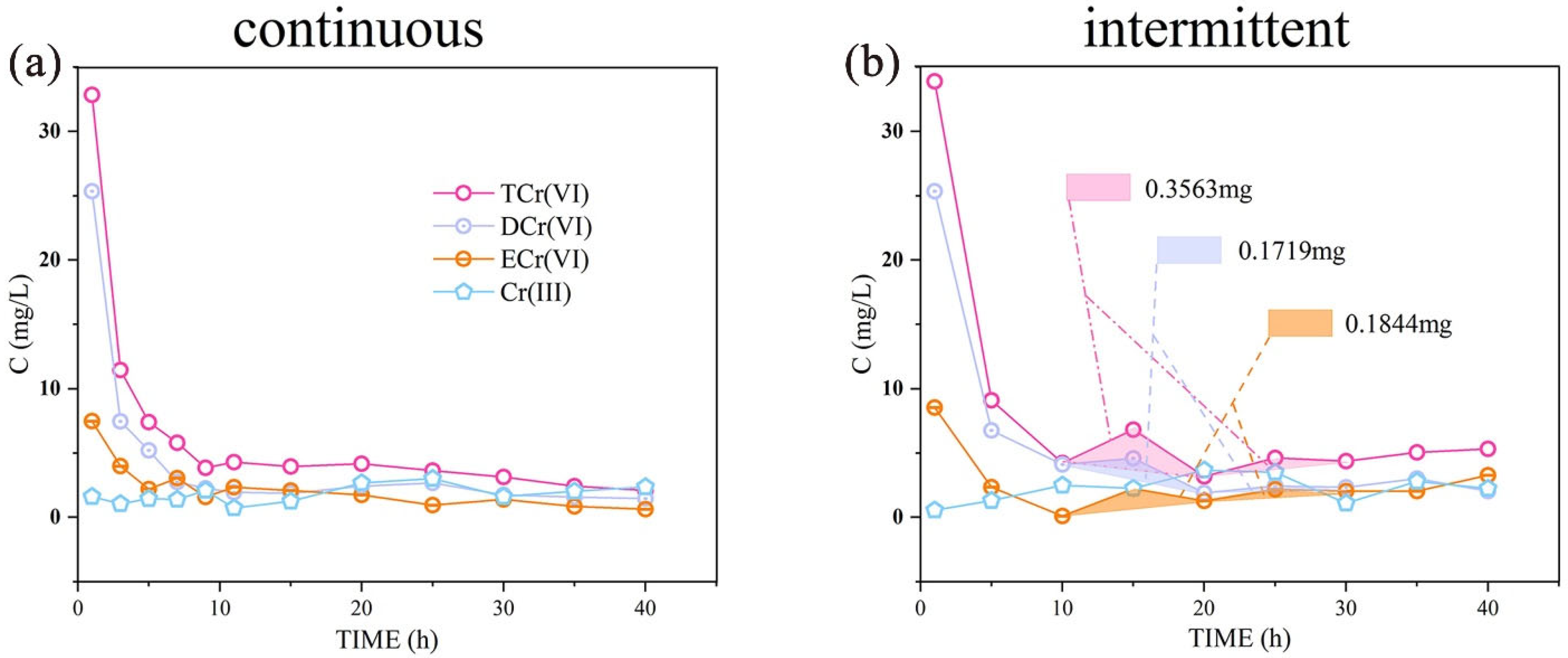Chromium Transport and Fate in Vadose Zone: Effects of Simulated Acid Rain and Colloidal Types
Abstract
1. Introduction
2. Materials and Methods
2.1. Study Area
2.2. Experimental Medium
2.3. Batch Experiment
2.4. Dynamic Leaching Experiment
2.5. Data Analysis
3. Results and Discussion
3.1. Binding between Cr (VI) and Colloid
3.2. Adsorption Efficiency of Different Colloids for Cr (VI)
3.3. Transport Behavior of Cr (VI)-Colloid System in Soil Columns
3.3.1. Effect of HA Colloid on Cr (VI) Release
3.3.2. Effect of Mt Colloid on Cr (VI) Release
3.4. Precipitation Alters the Transport Behavior of Cr (VI)
3.4.1. Effect of Acid Rain on the Leaching Release of Cr (VI)
3.4.2. Effect of Infiltration Mode on the Leaching Release of Cr (VI)
4. Conclusions
- HA colloids and Mt colloids in the vadose zone will combine with Cr. The agglomerates formed by HA colloids are more likely to be adsorbed and complexed onto the soil surface. Mt colloids have less influence on Cr. The fixation of Cr by colloid mainly occurs in the cinnamon soil layer containing HA colloid;
- The adsorption efficiency of Cr was increased by 12.8% with the addition of HA. In the HA-Cr system, the introduction of SO42− inhibited the adsorption of Cr, reducing the adsorption efficiency from 31.4% to 24.4%. The addition of Mt reduced the adsorption efficiency of Cr by 15%. In the Mt-Cr system, the introduction of SO42− had a promoting effect on Cr adsorption, with the adsorption efficiency increasing from 4.4% to 5.1%;
- Cr release was inhibited by 63.88% when HA colloid was present, but the inhibition owing to changes in acidity was only 14.47%. Mt colloid promotes Cr transport and increases the leaching rate by 2.64% compared to the absence of Mt. However, the effect of acidity change was not significant;
- Intermittent acid rain will enhance the effect of acid rain. Regarding site risk management, particular attention should be given to monitoring when acid rain stops and then starts again and to reducing water harvesting during this time;
- The type of colloid considerably impacts Cr release. During conditions of consistent acid rain intensity, the concentration of HA colloid at the site should be increased by applying organic fertilizers to reduce the risk of Cr release in the vadose zone.
Author Contributions
Funding
Institutional Review Board Statement
Informed Consent Statement
Data Availability Statement
Acknowledgments
Conflicts of Interest
References
- Iqbal, J.; Su, C.; Rashid, A.; Yang, N.; Baloch, M.Y.J.; Talpur, S.A.; Ullah, Z.; Rahman, G.; Rahman, N.U.; Sajjad, M.M.J.W. Hydrogeochemical assessment of groundwater and suitability analysis for domestic and agricultural utility in Southern Punjab, Pakistan. Water 2021, 13, 3589. [Google Scholar] [CrossRef]
- Baloch, M.Y.J.; Talpur, S.A.; Talpur, H.A.; Iqbal, J.; Mangi, S.H.; Memon, S.J.J.o.W.; Technology, E. Effects of Arsenic Toxicity on the Environment and Its Remediation Techniques: A Review. J. Water Environ. Technol. 2020, 18, 275–289. [Google Scholar] [CrossRef]
- Jat Baloch, M.Y.; Zhang, W.; Chai, J.; Li, S.; Alqurashi, M.; Rehman, G.; Tariq, A.; Talpur, S.A.; Iqbal, J.; Munir, M.J.W. Shallow Groundwater Quality Assessment and Its Suitability Analysis for Drinking and Irrigation Purposes. Water 2021, 13, 3361. [Google Scholar] [CrossRef]
- Jat Baloch, M.Y.; Zhang, W.; Zhang, D.; Al Shoumik, B.A.; Iqbal, J.; Li, S.; Chai, J.; Farooq, M.A.; Parkash, A.J.I.J.o.E.R.; Health, P. Evolution Mechanism of Arsenic Enrichment in Groundwater and Associated Health Risks in Southern Punjab, Pakistan. Int. J. Environ. Res. Public Health 2022, 19, 13325. [Google Scholar] [CrossRef]
- Zhang, W.; Chai, J.; Li, S.; Wang, X.; Wu, S.; Liang, Z.; Baloch, M.Y.J.; Silva, L.F.; Zhang, D.J.G.F. Physiological characteristics, geochemical properties and hydrological variables influencing pathogen migration in subsurface system: What we know or not? Geosci. Front. 2022, 13, 101346. [Google Scholar] [CrossRef]
- Jiang, W.; Cai, Q.; Xu, W.; Yang, M.; Cai, Y.; Dionysiou, D.D.; O’Shea, K.E. Cr(VI) adsorption and reduction by humic acid coated on magnetite. Environ. Sci. Technol. 2014, 48, 8078–8085. [Google Scholar] [CrossRef] [PubMed]
- Viti, C.; Marchi, E.; Decorosi, F.; Giovannetti, L. Molecular mechanisms of Cr(VI) resistance in bacteria and fungi. FEMS Microbiol. Rev. 2014, 38, 633–659. [Google Scholar] [CrossRef]
- Zhang, W.; Wu, S.; Qin, Y.; Li, S.; Lei, L.; Sun, S.; Yang, Y. Deposition and mobilization of viruses in unsaturated porous media: Roles of different interfaces and straining. Environ. Pollut. 2021, 270, 116072. [Google Scholar] [CrossRef]
- Qu, Z.H.; Zhao, Y.S.; Zhang, W.J.; Zong, F.; Huang, D.L. Contamination removal in landfill leachate by biological effect in sand layer of vadose zone. Huan Jing Ke Xue Huanjing Kexue 2008, 29, 344–348. [Google Scholar]
- Jing, C.; Liu, S.; Korfiatis, G.P.; Meng, X. Leaching behavior of Cr(III) in stabilized/solidified soil. Chemosphere 2006, 64, 379–385. [Google Scholar] [CrossRef]
- McClain, C.N.; Fendorf, S.; Johnson, S.T.; Menendez, A.; Maher, K. Lithologic and redox controls on hexavalent chromium in vadose zone sediments of California’s Central Valley. Geochim. Cosmochim. Acta 2019, 265, 478–494. [Google Scholar] [CrossRef]
- Rock, M.L.; James, B.R.; Helz, G.R. Hydrogen peroxide effects on chromium oxidation state and solubility in four diverse, chromium-enriched soils. Environ. Sci. Technol. 2001, 35, 4054–4059. [Google Scholar] [CrossRef]
- Sedumedi, H.N.; Mandiwana, K.L.; Ngobeni, P.; Panichev, N. Speciation of Cr(VI) in environmental samples in the vicinity of the ferrochrome smelter. J. Hazard. Mater. 2009, 172, 1686–1689. [Google Scholar] [CrossRef] [PubMed]
- Chen, H.; Teng, Y.; Lu, S.; Wang, Y.; Wang, J. Contamination features and health risk of soil heavy metals in China. Sci. Total Environ. 2015, 512–513, 143–153. [Google Scholar] [CrossRef]
- Sedlazeck, K.P.; Vollprecht, D.; Müller, P.; Mischitz, R.; Gieré, R. Impact of an in-situ Cr(VI)-contaminated site remediation on the groundwater. Environ. Sci. Pollut. Res. 2020, 27, 14465–14475. [Google Scholar] [CrossRef] [PubMed]
- Haque, F.; Chiang, Y.W.; Santos, R.M. Risk assessment of Ni, Cr, and Si release from alkaline minerals during enhanced weathering. Open Agric. 2020, 5, 166–175. [Google Scholar] [CrossRef]
- Rinklebe, J.; Shaheen, S.M.; Schröter, F.; Rennert, T. Exploiting biogeochemical and spectroscopic techniques to assess the geochemical distribution and release dynamics of chromium and lead in a contaminated floodplain soil. Chemosphere 2016, 150, 390–397. [Google Scholar] [CrossRef]
- Kanchinadham, S.B.K.; Narasimman, L.M.; Pedaballe, V.; Kalyanaraman, C. Diffusion and leachability index studies on stabilization of chromium contaminated soil using fly ash. J. Hazard. Mater. 2015, 297, 52–58. [Google Scholar] [CrossRef]
- Tantawy, M.A.; El-Roudi, A.M.; Salem, A.A. Immobilization of Cr(VI) in bagasse ash blended cement pastes. Constr. Build. Mater. 2012, 30, 218–223. [Google Scholar] [CrossRef]
- Kimbrough, D.E.; Cohen, Y.; Winer, A.M.; Creelman, L.; Mabuni, C. A Critical Assessment of Chromium in the Environment. Crit. Rev. Environ. Sci. Technol. 1999, 29, 10643389991259164. [Google Scholar] [CrossRef]
- Yang, J.; Xia, X.; Liu, J.; Wang, J.; Hu, Y. Molecular Mechanisms of Chromium(III) Immobilization by Organo–Ferrihydrite Co-precipitates: The Significant Roles of Ferrihydrite and Carboxyl. Environ. Sci. Technol. 2020, 54, 4820–4828. [Google Scholar] [CrossRef] [PubMed]
- Knappenberger, T.; Aramrak, S.; Flury, M. Transport of barrel and spherical shaped colloids in unsaturated porous media. J. Contam. Hydrol. 2015, 180, 69–79. [Google Scholar] [CrossRef] [PubMed]
- Li, Z.; Zhou, L. Cadmium transport mediated by soil colloid and dissolved organic matter: A field study. J. Environ. Sci. 2010, 22, 106–115. [Google Scholar] [CrossRef]
- Yin, X.; Gao, B.; Ma, L.Q.; Saha, U.K.; Sun, H.; Wang, G. Colloid-facilitated Pb transport in two shooting-range soils in Florida. J. Hazard. Mater. 2010, 177, 620–625. [Google Scholar] [CrossRef] [PubMed]
- Dalmacija, M.; Prica, M.; Dalmacija, B.; Roncevic, S.; Klasnja, M. Quantifying the environmental impact of As and Cr in stabilized/solidified materials. Sci. Total Environ. 2011, 412–413, 366–374. [Google Scholar] [CrossRef] [PubMed]
- Liao, Y.; Min, X.; Yang, Z.; Chai, L.; Liao, Q.; Wu, B. Assessment of the stability of chromium in remedied soils by Pannonibacter phragmitetus BB and its risk to groundwater. J. Soils Sediments 2014, 14, 1098–1106. [Google Scholar] [CrossRef]
- Larssen, T.; Seip, H.M.; Semb, A.; Mulder, J.; Muniz, I.P.; Vogt, R.D.; Lydersen, E.; Angell, V.; Dagang, T.; Eilertsen, O. Acid deposition and its effects in China: An overview. Environ. Sci. Policy 1999, 2, 9–24. [Google Scholar] [CrossRef]
- Carrington, N.A.; Thomas, G.H.; Rodman, D.L.; Beach, D.B.; Xue, Z.-L. Optical determination of Cr(VI) using regenerable, functionalized sol–gel monoliths. Anal. Chim. Acta 2007, 581, 232–240. [Google Scholar] [CrossRef]
- Pflaum, R.; Howick, L.C. The Chromium-Diphenylcarbazide Reaction1. J. Am. Chem. Soc. 1956, 78, 4862–4866. [Google Scholar] [CrossRef]
- Shanmugam, T.; Selvaraj, J.; Mani, U. An Improved Ion Chromatographic Method for Fast and Sensitive Determination of Hexavalent Chromium and Total Chromium Using Conductivity Detection. J. Chromatogr. Sci. 2020, 57, 939–943. [Google Scholar] [CrossRef] [PubMed]
- Mikhaylov, V.I.; Torlopov, M.A.; Krivoshapkina, E.F.; Martakov, I.S.; Krivoshapkin, P.V. Heteroaggregation of cellulose nanocrystals with Fe2O3 nanoparticles. J. Sol-Gel Sci. Technol. 2018, 88, 6–12. [Google Scholar] [CrossRef]
- von Wandruszka, R. Humic acids: Their detergent qualities and potential uses in pollution remediation. Geochem. Trans. 2000, 1, 10. [Google Scholar] [CrossRef]
- Colombo, C.; Palumbo, G.; Angelico, R.; Cho, H.G.; Francioso, O.; Ertani, A.; Nardi, S. Spontaneous aggregation of humic acid observed with AFM at different pH. Chemosphere 2015, 138, 821–828. [Google Scholar] [CrossRef] [PubMed]
- Chotpantarat, S.; Kiatvarangkul, N. Facilitated transport of cadmium with montmorillonite KSF colloids under different pH conditions in water-saturated sand columns: Experiment and transport modeling. Water Res. 2018, 146, 216–231. [Google Scholar] [CrossRef]
- Qin, Y.; Wen, Z.; Zhang, W.; Chai, J.; Liu, D.; Wu, S. Different roles of silica nanoparticles played in virus transport in saturated and unsaturated porous media. Environ. Pollut. 2020, 259, 113861. [Google Scholar] [CrossRef]
- Lu, K. Theoretical analysis of colloidal interaction energy in nanoparticle suspensions. Ceram. Int. 2008, 34, 1353–1360. [Google Scholar] [CrossRef]
- Scaglia, B.; Tambone, F.; Adani, F. Cr(VI) reduction capability of humic acid extracted from the organic component of municipal solid waste. J. Environ. Sci. 2013, 25, 487–494. [Google Scholar] [CrossRef]
- Zhilin, D.M.; Schmitt-Kopplin, P.; Perminova, I.V. Reduction of Cr(VI) by peat and coal humic substances. Environ. Chem. Lett. 2004, 2, 141–145. [Google Scholar] [CrossRef]
- Farsang, S.; Louvel, M.; Rosa, A.D.; Amboage, M.; Anzellini, S.; Widmer, R.N.; Redfern, S.A.T. Effect of salinity, pressure and temperature on the solubility of smithsonite (ZnCO3) and Zn complexation in crustal and upper mantle hydrothermal fluids. Chem. Geol. 2021, 578, 120320. [Google Scholar] [CrossRef]
- Kumpulainen, S.; von der Kammer, F.; Hofmann, T. Humic acid adsorption and surface charge effects on schwertmannite and goethite in acid sulphate waters. Water Res. 2008, 42, 2051–2060. [Google Scholar] [CrossRef]
- Zhang, L.; Fu, F.; Yu, G.; Sun, G.; Tang, B. Fate of Cr(VI) during aging of ferrihydrite-humic acid co-precipitates: Comparative studies of structurally incorporated Al(III) and Mn(II). Sci. Total Environ. 2022, 807, 151073. [Google Scholar] [CrossRef] [PubMed]
- Chen, G.; Liu, X.; Su, C. Distinct effects of humic acid on transport and retention of TiO2 rutile nanoparticles in saturated sand columns. Environ. Sci. Technol. 2012, 46, 7142–7150. [Google Scholar] [CrossRef] [PubMed]
- Ma, J.; Guo, H.; Lei, M.; Wan, X.; Zhang, H.; Feng, X.; Wei, R.; Tian, L.; Han, X. Blocking effect of colloids on arsenate adsorption during co-transport through saturated sand columns. Environ. Pollut. 2016, 213, 638–647. [Google Scholar] [CrossRef] [PubMed]
- Wang, Y.; Gong, Y.; Lin, N.; Yu, L.; Du, B.; Zhang, X. Enhanced removal of Cr(VI) from aqueous solution by stabilized nanoscale zero valent iron and copper bimetal intercalated montmorillonite. J. Colloid Interface Sci. 2022, 606, 941–952. [Google Scholar] [CrossRef] [PubMed]
- Liu, W.; Li, J.; Zheng, J.; Song, Y.; Shi, Z.; Lin, Z.; Chai, L. Different Pathways for Cr(III) Oxidation: Implications for Cr(VI) Reoccurrence in Reduced Chromite Ore Processing Residue. Environ. Sci. Technol. 2020, 54, 11971–11979. [Google Scholar] [CrossRef]





| Type of Medium | pH | Sample Depth (m) | Minimum Particle Size (mm) | Maximum Particle Size (mm) | Specific Surface Area (m2/g) | Porosity | TOC (mg/g) |
|---|---|---|---|---|---|---|---|
| Cinnamon soil | |||||||
| Mean + standard error | 7.77 + 1.12 | 0.2–0.5 | 0.21 + 0.01 | 0.41 + 0.01 | 0.37 + 0.02 | 0.432 + 0.010 | 3.314 + 0.020 |
| Silt | |||||||
| Mean + standard error | 7.82 + 0.92 | 3.0–4.0 | 0.19 + 0.00 | 0.39 + 0.01 | 0.24 + 0.01 | 0.337 + 0.008 | 2.883 + 0.077 |
Publisher’s Note: MDPI stays neutral with regard to jurisdictional claims in published maps and institutional affiliations. |
© 2022 by the authors. Licensee MDPI, Basel, Switzerland. This article is an open access article distributed under the terms and conditions of the Creative Commons Attribution (CC BY) license (https://creativecommons.org/licenses/by/4.0/).
Share and Cite
Zhang, W.; Zhao, K.; Wan, B.; Liang, Z.; Xu, W.; Li, J. Chromium Transport and Fate in Vadose Zone: Effects of Simulated Acid Rain and Colloidal Types. Int. J. Environ. Res. Public Health 2022, 19, 16414. https://doi.org/10.3390/ijerph192416414
Zhang W, Zhao K, Wan B, Liang Z, Xu W, Li J. Chromium Transport and Fate in Vadose Zone: Effects of Simulated Acid Rain and Colloidal Types. International Journal of Environmental Research and Public Health. 2022; 19(24):16414. https://doi.org/10.3390/ijerph192416414
Chicago/Turabian StyleZhang, Wenjing, Kaichao Zhao, Bo Wan, Zhentian Liang, Wenyan Xu, and Jingqiao Li. 2022. "Chromium Transport and Fate in Vadose Zone: Effects of Simulated Acid Rain and Colloidal Types" International Journal of Environmental Research and Public Health 19, no. 24: 16414. https://doi.org/10.3390/ijerph192416414
APA StyleZhang, W., Zhao, K., Wan, B., Liang, Z., Xu, W., & Li, J. (2022). Chromium Transport and Fate in Vadose Zone: Effects of Simulated Acid Rain and Colloidal Types. International Journal of Environmental Research and Public Health, 19(24), 16414. https://doi.org/10.3390/ijerph192416414






